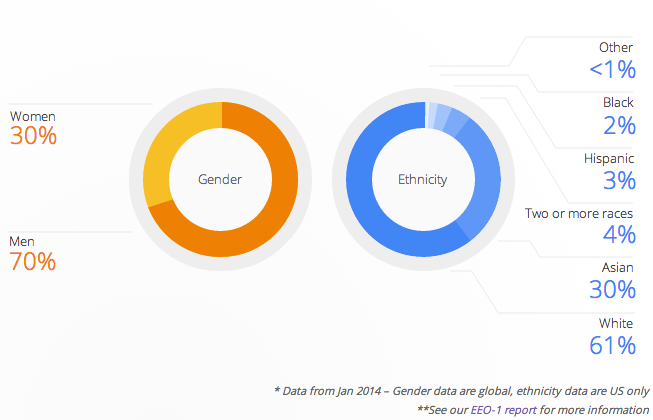A blog posted yesterday by Google Inc. has been getting attention and becoming the topic of discussion on social media. The search giant is being surprisingly candid about its failure to achieve a diverse workforce and disclosing a rare peek into the makeup of its workforce.
Looking at this chart that breaks down Google employees into gender and ethnicity, it’s easy to see the dominant group of workers at Google is male and white. That may come as no surprise to those that work in the technology industry, but that doesn’t mean it’s not worth talking about.

Google’s unveiling of its problem is at least accompanied by the stated will to address it and overcome it. To do so, it’s donated more than $40 million to organizations that are working to bring computer science education to females. It’s also worked with specific colleges in the U.S. to improve computer science programs for areas traditionally serving minorities.
Unfortunately Google’s situation is not unique in any way, and certainly not a problem limited to the U.S., nor is it limited to the field of computer science. A recent report from the European Audiovisual Observatory revealed a low percentage of women in creative roles in the film and television industry. For example, a woman sat in the director’s chair only 16.1 per cent of the time between 2003-2013. It seems that just as women are often blocked from the top jobs in the business world, they are also unlikely to get a shot at the top credit role in the entertainment world.
Here in Canada, gender inequality still very much exists and its reach goes beyond age and education. The proof is in the census data collected by Statistics Canada and if you doubt that it’s true, try an experiment using this calculator tool from the Vancouver Sun’s Chad Skelton. Punch the gender, age, education, and ethnicity that match your details. Now leave everything the same and change the gender field to be the opposite. How does it change the income level? In my case, the average salary drops by about $6,000 per year when I change the gender modifier from male to female.
We're holding a Twitter chat today on #womenintech & leadership! Tweet with us at #CDNWomen at 1pm ET!
— Channel Daily News (@CDN_Channel) May 29, 2014
There’s no excuse for organizations to not work on this problem. After all, we know having more women in leadership roles is good for business. Take the report from Catalyst that shows that Fortune 500 companies with more women on their boards outperform those with few or no women on their boards. Not only is improved gender equality good for society, it’s good for the bottom line.
At IT World Canada, we’re discussing the issue of women leadership in the IT sector today and specifically addressing those working for channel partners. We’ll be joined by our own president, Fawn Annan, as well as Jennifer Johnson, senior director of marketing for Ingram Micro and Corrine Sharp, president of Sharp Perspective Inc, just to name a few. Join us at the #CDNwomen hashtag at 1:00 PM ET.




